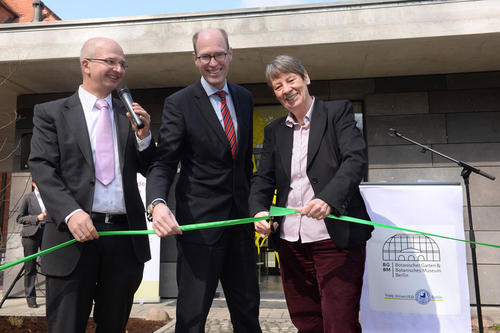“Reinsurance for Life”
New wild plant seed bank building at the Botanic Garden of Freie Universität now open
May 20, 2015
Opening of the seed bank: German Federal Environment Minister Dr. Barbara Hendricks (right) with the director of the Botanic Garden, Dr. Thomas Borsch, Professor (left), and the president of Freie Universität Berlin, Dr. Peter-André Alt, Professor
Image Credit: David Ausserhofer
Preserving diversity: At the opening, the minister said that the seeds stored at the seed bank were “reinsurance for life.”
Image Credit: Botanischer Garten und Botanisches Museum Berlin
The seeds, which have been dried to a water content of less than eight percent, are ready to be placed in frozen storage. It is hoped that this will keep them capable of germinating for decades, perhaps even centuries.
Image Credit: A. Obermüller
The Dahlem Seed Bank houses about 7,000 different seed samples, many of them from rare or endangered plant species. The collection functions as a kind of plant archive, and it is an important partner in dialogue and exchange with botanical gardens around the world. Last week, the new building to house the prestigious institution was officially opened by the German Federal Environment Minister Dr. Barbara Hendricks, the seed bank’s patron.
The survival of many species of plants is at risk due to various factors, including not only climate change, but also population growth and the decrease in space left in its natural state. “This means the living wealth of the Earth is at stake,” the minister warned in her speech – riches that could not be bought back, not even with all the money in the world, once they are lost. “We need a kind of reinsurance for life. And the Dahlem Seed Bank offers us just that kind of insurance,” Hendricks said.
The collection’s areas of focus include “native German wild plant species as well as the Mediterranean and the Caucasus,” says Thomas Borsch, the director of the Botanic Garden and Botanical Museum of Freie Universität Berlin, to which the seed bank belongs. While wild plants often garner less attention than crops, he says that preserving wild plants in a gene bank is also of fundamental importance in a number of ways. “If necessary, we can raise plants this way and support populations in nature, says Borsch, a biologist who specializes in biodiversity and plant evolution.
Optimum Conditions for Long-term Storage
Because the seeds stored at the bank will stay capable of germination for decades – and possibly in some cases even centuries – Borsch says the seed bank is an important institution. “Measures to protect nature on site often do not take effect fast enough to guard against the loss of populations of endangered species.”
“Among other things, a private estate allowed us to finance the new building for the seed bank,” Borsch says. “In the new building, we now have state-of-the-art labs and germination cabinets,” he adds. This means that the new seed bank offers optimum conditions for professional cleaning, drying, and storage of seeds. “With the seed bank, we are making a proactive contribution to protecting nature and preserving plant resources worldwide,” Borsch says, continuing that researchers can engage in targeted study to determine the conditions under which wild plant seeds germinate and remain germinable.
Contribution to Protecting Nature
The Berlin Botanic Garden works closely with environmental protection agencies and is already engaged in initial projects to cultivate plants belonging to endangered species from seeds in the seed bank in order to resettle them in their original site in nature or to bolster severely diminished populations. Knowledge of the genetic variability of species is crucial in this process, Borsch says. By integrating the work being done by the seed bank and his research programs on plant biodiversity, the Berlin Botanic Garden as a scientific institution can make an especially targeted, effective contribution to nature conservation efforts. However, Borsch cautions that habitat protection is the most important thing when it comes to giving a wild plant species a chance of survival in nature. “Due to changes in land use, the intensification of agriculture, and infrastructure activities such as building roads, we are experiencing a significant decline in many plant populations worldwide,” Borsch says. He adds that about three-quarters of all habitats in Germany are threatened.
Further Information
Thomas Borsch, Director, Botanic Garden and Botanical Museum, Freie Universität Berlin, Tel.: +49 30 838-50100



